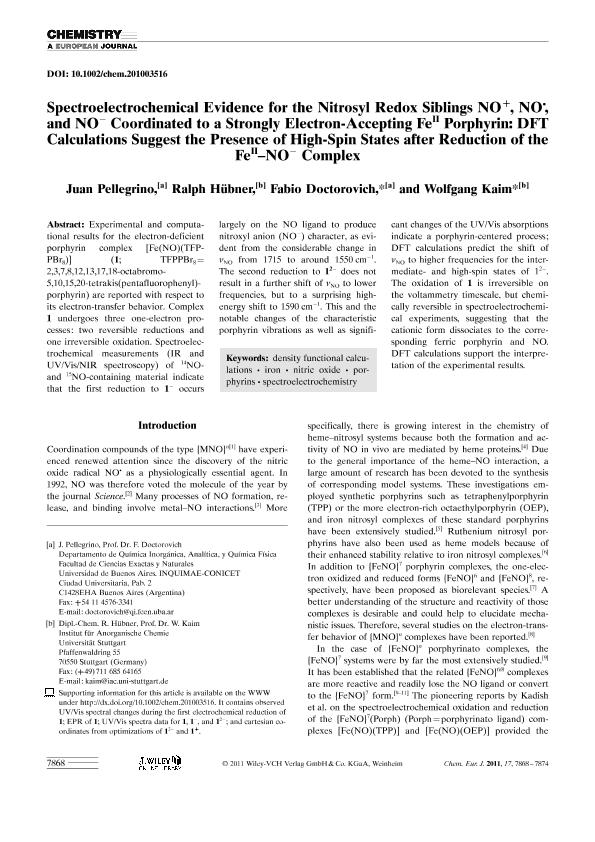Artículo
Spectroelectrochemical evidence for the nitrosyl redox siblings NO +, NO., and NO- coordinated to a strongly electron-accepting FeII porphyrin: DFT calculations suggest the presence of high-spin states after reduction of the FeII-NO - complex
Fecha de publicación:
07/2011
Editorial:
Wiley VCH Verlag
Revista:
Chemistry- A European Journal
ISSN:
0947-6539
Idioma:
Inglés
Tipo de recurso:
Artículo publicado
Clasificación temática:
Resumen
Experimental and computational results for the electron-deficient porphyrin complex [Fe(NO)(TFPPBr8)] (1; TFPPBr8=2,3,7,8,12,13,17, 18-octabromo-5,10,15,20-tetrakis(pentafluorophenyl)porphyrin) are reported with respect to its electron-transfer behavior. Complex 1 undergoes three one-electron processes: two reversible reductions and one irreversible oxidation. Spectroelectrochemical measurements (IR and UV/Vis/NIR spectroscopy) of 14NO- and 15NO-containing material indicate that the first reduction to 1- occurs largely on the NO ligand to produce nitroxyl anion (NO-) character, as evident from the considerable change in νNO from 1715 to around 1550 cm-1. The second reduction to 12- does not result in a further shift of νNO to lower frequencies, but to a surprising high-energy shift to 1590 cm-1. This and the notable changes of the characteristic porphyrin vibrations as well as significant changes of the UV/Vis absorptions indicate a porphyrin-centered process; DFT calculations predict the shift of νNO to higher frequencies for the intermediate- and high-spin states of 12-. The oxidation of 1 is irreversible on the voltammetry timescale, but chemically reversible in spectroelectrochemical experiments, suggesting that the cationic form dissociates to the corresponding ferric porphyrin and NO. DFT calculations support the interpretation of the experimental results. En este trabajo se estudia el comportamiento redox del complejo {FeNO}7 con sustituyentes atractores de electrones, [Fe(NO)(TFPPBr8)]=1 (TFPPBr8=2,3,7,8,12,13,17,18- octabromo-5,10,15,20-tetrakis(pentafluorofenil)porfirina) mediante experimentos de espectroelectroquímica y cálculos computacionales. El complejo 1 presenta tres procesos electroquímicos de un electrõn: dos reducciones reversibles y una oxidaciõn irreversible. El considerable cambio de νNO de 1715 cm-1 a ≈ 1550 cm-1 indica que la primera reducciõn a 1- involucra en gran medida al ligando NO. Para la segunda reducciõn a 12- se observa, sorprendentemente, un cambio de νNO a ≈ 1590 cm-1. Este pequeño corrimiento de νNO y los cambios notables de las vibraciones asociadas a modos de la porfirina, así como los cambios significativos en la banda UV/Vis de Soret, indican un proceso centrado en la porfirina; los cálculos DFT predicen el corrimiento de νNO a mayores frecuencias para los estados de spin intermedio y alto de 1 2-. En cuanto a la oxidaciõn de 1, la onda irreversible en la voltametría cíclica sugiere que la forma catiõnica 1 + se disocia dando la porfirina de hierro(III) y NO; sin embargo, en el experimento espectroelectroquímico el proceso resulta reversible, recuperándose la νNO de 1 al reducir. Los cálculos DFT apoyan la interpretaciõn de los resultados experimentales. All in a spin: IR and UV/Vis spectroelectrochemistry reveal that the oxidation and the first reduction of [Fe(NO)(TFPPBr8)] (TFPPBr8= 2,3,7,8,12,13,17,18-octabromo-5,10,15,20-tetrakis(pentafluorophenyl)porphyrin) mainly affect the FeNO moiety. In the two-electron-reduced form, the added electrons appear mainly located on the porphyrin, and DFT calculations suggest an intermediate- or high-spin state (see figure).
Archivos asociados
Licencia
Identificadores
Colecciones
Articulos(INQUIMAE)
Articulos de INST.D/QUIM FIS D/L MATERIALES MEDIOAMB Y ENERGIA
Articulos de INST.D/QUIM FIS D/L MATERIALES MEDIOAMB Y ENERGIA
Citación
Pellegrino, Juan; Hübner, Ralph; Doctorovich, Fabio; Kaim, Wolfgang; Spectroelectrochemical evidence for the nitrosyl redox siblings NO +, NO., and NO- coordinated to a strongly electron-accepting FeII porphyrin: DFT calculations suggest the presence of high-spin states after reduction of the FeII-NO - complex; Wiley VCH Verlag; Chemistry- A European Journal; 17; 28; 7-2011; 7868-7874
Compartir
Altmétricas




